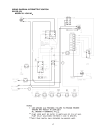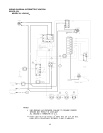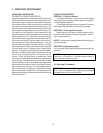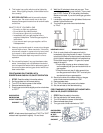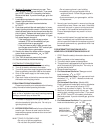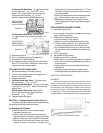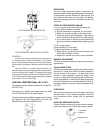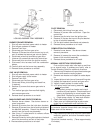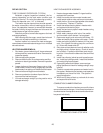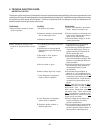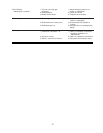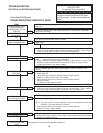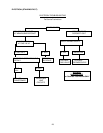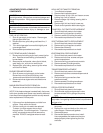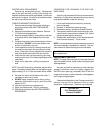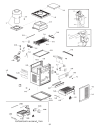
HEAT EXCHANGER RE-ASSEMBLY
1. Heat exchanger water header O-rings should be
replaced with new ones.
2. Install inlet-outlet and return water headers and
install header retainer nuts and torque nuts evenly.
3. Install the four (4) corner clips between tube sheets
and refractory. Replace "V" baffles.
4. Install thermostat sensing bulbs in header wells
and replace bulb retaining clips.
5. Install inlet and return pipes in water headers using
pipe thread sealant.
6. Install water pressure relief valve, flow switch,
and low water cutoff devices if so equipped.
7. Open water supply and return shut-off valves. Fill
heater and water piping system with water. Check
heater and piping system for leaks at full line pres-
sure. Run system circulating pump for a minimum
of 1/2 hour with heater shut-off.
8. Shut down entire system and vent all radiation units
and high points in system piping. Check all strain-
ers for debris. Expansion tank water level should
be at the 1/4 mark and the balance of the tank filled
with air.
9. Install flue collector, jacket top and inspection pan-
els. Install top holding screws. Install draft diverter
and vent piping if so equipped.
10. If gas piping was disconnected, reconnect gas
piping system and check for leakage using a soap
solution.
11. Check for correct water pressure and water level in
the system. Make sure that system pump operates
immediately on the call for heat. The system is
ready for operation.
12. Within two (2) days of start-up, recheck all air vents
and expansion tank levels.
COMBUSTION CHAMBER REMOVAL
To remove combustion chamber you must first have
removed the heat exchanger. Unbolt metal combustion
chamber retainer from top and remove combustion cham-
ber panels individually.
REFRACTORY PANELS TOP VIEW
REPAIR SECTION
TUBE CLEANING PROCEDURE (TYPICAL)
Establish a regular inspection schedule, the fre-
quency depending on the local water condition and
severity of service. Do not let the tubes clog up solidly.
Clean out deposits over 1/16" in thickness.
The heater may be cleaned from the side opposite
the water connections, without breaking pipe connec-
tions. It is preferable, however, to remove both headers
for better visibility through the tubes and to be sure the
residue does not get into the system.
Note that you do not remove the top pan or the heat
exchanger generally.
After reaming with the auger, mount the wire brush
and clean out the debris remaining in the tubes.
Another method is to remove the heat exchanger,
ream tubes and immerse heat exchanger in non-inhibited
de-scale solvent.
HEAT EXCHANGER REMOVAL
1. Shut water, gas and electricity off, close valves and
relieve pressure, remove relief valve. Remove side
inspection panels.
2. Remove top holding screws.
3. Remove draft diverter, lift and remove top and flue
collector on stack type models. Remove inspection
panels.
4. Loosen bolts and disconnect flange nuts on inlet-
outlet header, loosen union(s) at gas pipe, and slide
heater away from piping until studs clear the heater.
5. Remove heat exchanger corner brackets.
6. Remove combustion chamber clips at the four
corners of the heat exchanger.
7. Lift heat exchanger straight up using caution not to
damage refractory.
25



